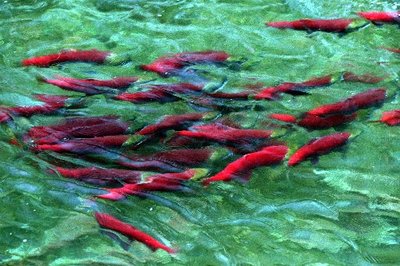forum
library
tutorial
contact

A New Chance for Snake River Salmon
by Tim PalmerHigh Country News, August 19, 2011
|
the film forum library tutorial contact |

|
A New Chance for Snake River Salmonby Tim PalmerHigh Country News, August 19, 2011 |
 With his Aug. 2 ruling that the federal government's plan for
salmon recovery once again fails to meet requirements of the law,
U.S. District Court Judge James Redden has opened the door to a
hopeful approach in efforts for recovery of wild salmon in the
Columbia and Snake Rivers. A better plan can be at once visionary,
effective and economically beneficial for the people of the West
and the nation. And it requires no great stretch of imagination.
With his Aug. 2 ruling that the federal government's plan for
salmon recovery once again fails to meet requirements of the law,
U.S. District Court Judge James Redden has opened the door to a
hopeful approach in efforts for recovery of wild salmon in the
Columbia and Snake Rivers. A better plan can be at once visionary,
effective and economically beneficial for the people of the West
and the nation. And it requires no great stretch of imagination.
The solution will be demonstrated this fall on Washington's Elwha River when the demolition of two tall dams gets under way. A great salmon river will, after a century, return to life. Many people will cheer the river's reinstated flow, earn new livelihoods from its reinvigorated life, and share in the glow of achievement.
The same thing can happen on the lower Snake River where four dams block salmon on their spawning journeys. The Obama plan and those of the previous two administrations were not just against the law; they were plans designed to protect the past. But the way we've used this great river in the past will no longer work in the future. More needs can be satisfied and more money earned from a river that's allowed to do the work that healthy rivers do so well, ever since the salmon began their great migrations.
Recent surges in the numbers of fish returning to spawn offer little hope that the fundamental problems of the imperiled species have been solved. From historic highs of 16 million fish, the returns -- even in the productive year of 2009 -- were just a fraction of that: 2.2 million, and only an estimated 400,000 of those salmon were wild fish. The vast majority started their lives in hatcheries, which in some ways endanger the wild fish that naturally spawn in the rivers. Thirteen distinct runs of wild fish are listed as endangered or threatened, with populations well below the benchmarks for species survival.
Removing the four lower Snake River dams would restore healthy runs of salmon; it would create thousands of jobs in fishing, food, railroads and construction; and it would make our shared homeland here in the Northwest a better place for the next generation. To accomplish all this, we need to replace only 4 percent of the Northwest's electricity with affordable efficiency improvements and clean renewable energy -- creating additional jobs in the process. Railroads and road improvements can replace subsidized barging on the lower Snake upstream from Pasco, which constitutes only a small percentage of the Columbia River's barging.
While writing about rivers for the past 30 years, I've canoed, rafted and explored the waters in every corner of our nation, and the most remarkable change I've seen is the work of river restoration. People from Boise to Sacramento and from Los Angeles to Boston are resurrecting watery lifelines in ways that benefit not only fish but also communities and economies. By restoring rivers we show an essential sense of who we are as a people -- a nation that recognizes the value of heritage but refuses to remain stuck in the past, a nation that thrives because we allow nature to thrive around us.
As you watch the Elwha dams come down this fall, think of the other opportunities that lie ahead. Twenty years ago, restoring the Elwha seemed like an impossible dream; skeptics claimed that it would cost jobs and dishonor the past. But visionary -- and practical -- people prevailed, and a restored river will become a reality.
The opportunity being seized at the Elwha is not unique. For the Snake River, Judge Redden's ruling requires a legitimate salmon plan that includes removing dams. Great possibilities beckon, but only if we are willing to look toward tomorrow. As Abraham Lincoln said, "We must disenthrall ourselves from the past. We must look anew, and think anew."
learn more on topics covered in the film
see the video
read the script
learn the songs
discussion forum
